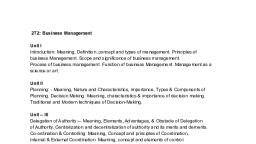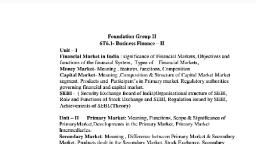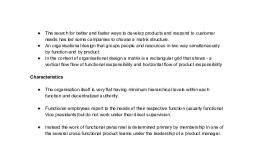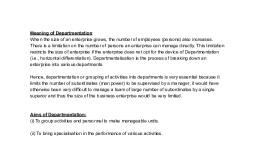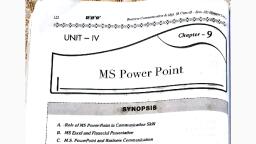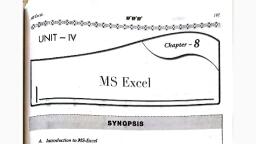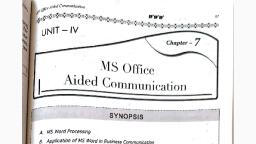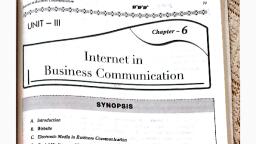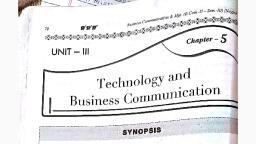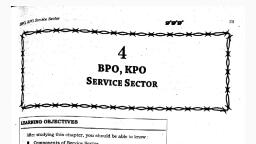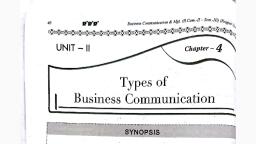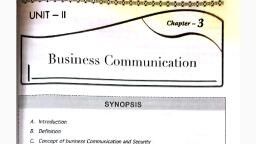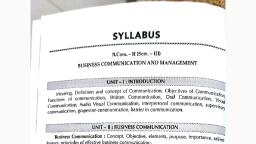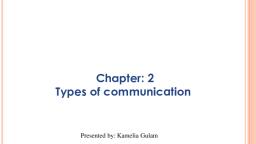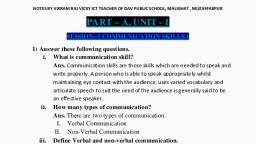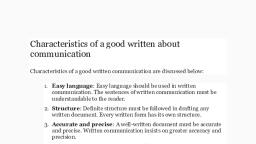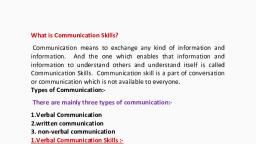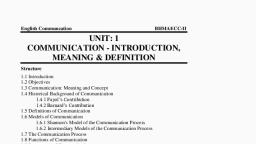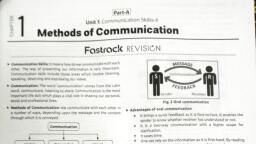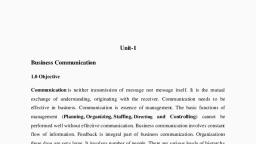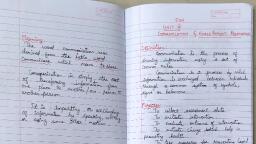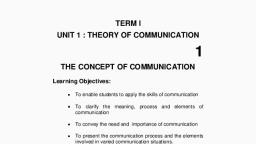Page 2 :
ir Uni), SEan Types of Communication, A. INTRODUCTION, The scope of modem business is vast. The field of business and industry is, increasing with leaps and bounds all over the world. Due to the new economic, policy of liberalisation, privatization and globalization adopted by the Indian, government, the technological revolution and such other many factors, the world, of business is ever-increasing. The growth of business sector and that of, communication sector go hand in hand. The communication becomes an, indispensable activity in an organisation for maintaining continuous liaison and, interaction with the internal members of the organisation and also with the, outsiders. The managers, executives, supervisors, foremen, administrative, personnel and the manual workers are all the people who are continuously, engaged in the task of production or distribution of goods or sale of services for, the market., With the growth of consumer demand and scientific and technological, researches and inventions, the scale of production and distribution of modern, business firms has increased tremendously. It 'has resulted in the formation of, large-sized business units employing large number of people in different positions, and also the use of huge and sophisticated machineries required for production., The markets are widened and the consumers are all spread over a long, distance. Internationalism has become the order of the day in the field of, business., B. NEED OF COMMUNICATION IN BUSINESS, As it has been pointed out earlier that communication is essential. to, business as the blood stream is to a man. In the past, due to the slow growth of, business and its scope being limited to the local areas, the scope of, communication was also limited. The use of postcards, telegrams, letters written, by hand were the popular means of communication., However, today the scope of communication, its complexity and the kinds, have largely increased mainly due to the growth of communication technology., The extensive use of telephones, television, cinema movies, video-shootings,, computers, video conferencing and, communication devices has become a common practice in day-to-day life of the, people and more especially in the field of business., many, other electronically operated, C. TYPES OF COMMUNICATION, The organisational communication takes place in different ways and in, different forms and directions. The following diagram depicts the different types of, communication., All these types of organisational communications are described below., 1. Oral Communication, In oral communication, the transmission of message takes place through the, words spoken by the parties. Speaking with others denotes oral or verbal, communication. In an organisational setting, the managers, executives and for, that matter every member of the organisation has to orally convey messages to, each other. The managers may issue verbal orders and instructions to their, subordinates directly face-to-face or by telephone. The oral communication, to be, effective requires specific art or skill on the part of the communicator. The, following are the advantages and disadvantages of oral communication.., Scanned by CamScanner
Page 3 :
The method of oral communication in an organisational setting assists in, By saving of. time and cost of communication, the managerial efficiency and, This method assists in strengthening of the relations between the parties, executing and fulfilling major amount of tasks, duties and responsibilities of, 10, Business Communication & Mgt. (B.Com.-II- Sem.-I) (Nagpur Un, Туре, Business Communication at a glance, D, E, cor, On the basis of, On the basis of, On the basis of, On the basis of, On the basis of, in, method of, media of, relationships, parties, (1) Formal, communication, direction or flow, location of, ma, communication, communication, parties in, communication, of communication, (1) Oral comm-, (1) Through, (1) Horizontal, unication, channel of, (1) Internal, Operational, communication, communication, (2) Written comm-, (2). Informal, (2) Vertical, command, unication, communication, (2) Bulleting, communication, (3) Gestural comm-, Boards, (3) Diagonal, communication, (2) External, öpetational, communication, (3) Meeting and, conferences, unication, or Body, languages, (4) Downward, communication, (4) Announčements, (5) Suggestión boxes, (6) Grievance, machinery, (7) Company, publications, (8) Group cómmunication, (9) Visual communication, (3) International, communication, (5) Upwałd, communication, (6) One-way, Communication, (7) Two-way, Communication, Advantages, The advantages of oral communication are as follows:, i) Saving of time, efforts and cost, As the speed of oral communication is more and the feedback obtained is, quick, it saves on account of time, efforts and cost of communication to the, organisation., ii) More effective, Oral communication is more effective. As the parties to such communication, convey their messages and information face-to-face, the .doubts, queries,, suspicions and difficulties can be remnoved on the spot., iii) Greater understanding, Under this type of communication, there is greater understanding of the, message. In the event of any misunderstanding, the message may be repeated, and re-explained to the receiver., iv) Flexibility, This tyne of communication is more flexible and can be / adapted and, adiusted according to the need of tne time, situation and the status' of the, receiver., v) Bettering of relations, mainly due to the elimination of misunderstanding., vi) Greater efficiency and productivity, organisational productivity is enhanced., vii) Quick execution of tasks, managers., Scanned by CamScanner
Page 4 :
11, Types of Communication, > Disadvantages, Despite the fact that oral communication is an old, traditional or, conventional practice of conveying information and mèssages and is widely used, in the organisations even today, it has certain limitations and it suffers from, many drawbacks. The following are the main disadvantages of oral or verbal, „3,8,8, communication., i) Need for face-to-face meeting : Oral communication can be materialized, only when both the parties to communication meet face-to-face. It may, also be held telephonically., ii) Expensive method: It may prove to be an expensive method of, communication if the parties are at long distance. For example, the, charges of telephone calls for cóntacting the person in other countries are, too heavy., iii) Inconvenience : The oral communication may prove to be inconvenient, and ineffective, if the communicator lacks needed skill to communicate or, the receiver lacks needed intelligence to understand the message., iv) No evidence left In oral communication, there is no evidence that, certain message is transmitted and received. The communicatee may, refuse such receipt of the message., v) No time for thinking : The method of oral communication fails to provide, adequate time for thinking, planning and organising the mėssage to be, conveyed and responded. Hasty transmission and feedback may prove to, be wrong and ineffective., vi) No-future referencing : In the absence. of any documentation, oral, communication cannot be used for future reference., 2. Written Communication, This type of communication is in black and white. It is in the form of, documentation or paper work. These are the written messages which are drafted, after giving full thought, choosing proper words and language and ensuring, clarity and understandability of the subject-matter under consideration. It should, be seen while drafting letters, circulars, reports, memorandum, notices and such, other written messages that it, will have a desired effect on the mind of the, receiver and proper feedback or response is obtained from him., The advantages and disadvantages of written, summarised as follows., communication, are, > Advantages, Advantages are as follows :, i) No need of personal contact In written communication there is no, need of personal contact and meeting between the parties., ii) Greater clarity of message : As the message is pre-planned and well-, organised, its adequacy and clarity is ensured., iii) Low cost : The cost of written communication is relatively low., iv) Written evidence : Due. to documentation and paperwork, it provides, written evidence for future reference. It may be used in the court of law as, a legal proof in times of any dispute between the parties., v) Message can be sent to many : The same message can be sent to many, persons at à time through the devices like circulars, television etc., 2/B.Com.-II-Bus. Comm. & Mgt (Sem.-III)-Nagpur Uni, Scanned by CamScanner
Page 5 :
Business Communication & Mgt. (B.Com.-II – Sem.-III) (Nagpur U, 12, 8,8,8, The following are the disadvantages of written communication :, i) Time consuming : Planning, organising and drafting of the message, proper form is a time consuming process., Disadvantages, ii) Lack of secrecy : As the written messages are likely to go from one har, to the other in the course of their transmission, the secrecy cannot F, maintained., by writte, iii) Delayed transmission, communication requires greater time to reach to the transmitter, communicatee or the receiver., The message transmitted, :, 1v) No use for illiterate people : The written communication is of little us, and benefit to those who are illiterate., v) No prompt feedback : It does not ensure the quick and proper feedbacl, from the receiver of the message., 3. Inter-personal communication, Not all the communication that goes on in an organisation is operational bui, much of it may be more exchanges of feelings and information among the people., It is called as inter-personal communication. However it may affect workers, viewpoints., The inter-personal communication, thus may be defined, as all such, incidental exchange of information and feelings in which the human being is, engage themselves when they come together. The human being are the social, animals. They feel a need to communicate with their fellow beings. They may, communicate even when they'have little or nothing to say. Even the strangers are, likely to communicate when they are placed together., Such personal communication is also effected in the work situation and it is, a part of-communication activity of any business organisation. Even though such, communication has a little concern with the day-to-day operations of the, business firm, it has a significant effect on its success. It reveals the viewpoints,, opinions, attitudes and beliefs of the members of organisation towards their, organization, follow workers and their assignments. However, excessive, communication of this kind in a workplace can interfere with the work output. It, should therefore be controlled by managers., Theories of Interpersonal Communication, Various theories have been developed by social scientists and psychologists, to find out the logic and reasoning behind the inter-personal communication, within and outside the work situation. Among them are mainly the scientists like, William Shuts, Leavy, Eric Barne, Abraham Maslow, Herzberg and Me Gregor., They have propounded different theories of inter-personal communication. Few of, these theories are stated below., William Shut's theory of inter-personal communication, The basis of William Shut's theory of inter-personal communication lies in, the human needs. The basic reason why a person wants to live in groups,, term his duties and responsibilities in an organisation and also interact with, the members of the society lies in need-satisfaction., When a person works with an employing organisation, he is enabled to earn, his income, However it may not enable him to satisfy all his needs which are, unsatiable., A man is governed by innumerable needs. The primary, physiological, biological needs, safety and security needs, sociological, need-, Scanned by CamScanner
